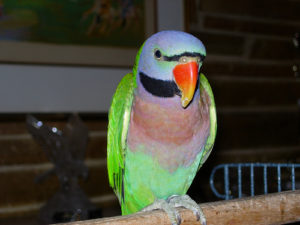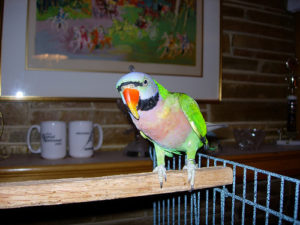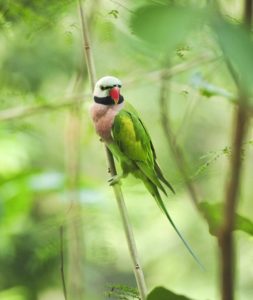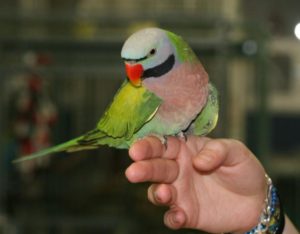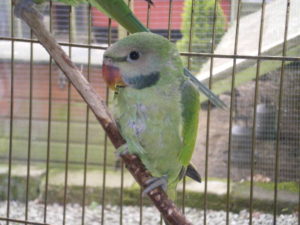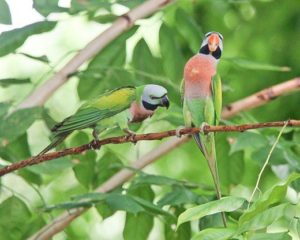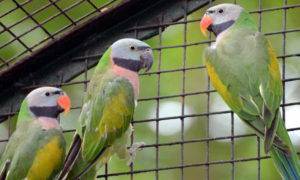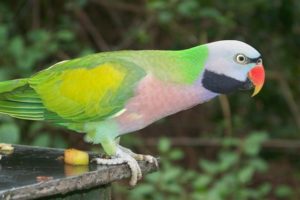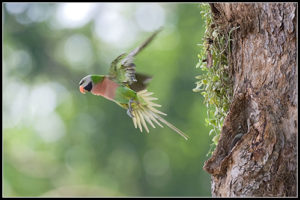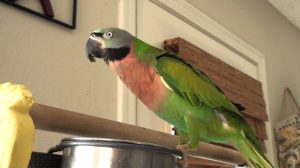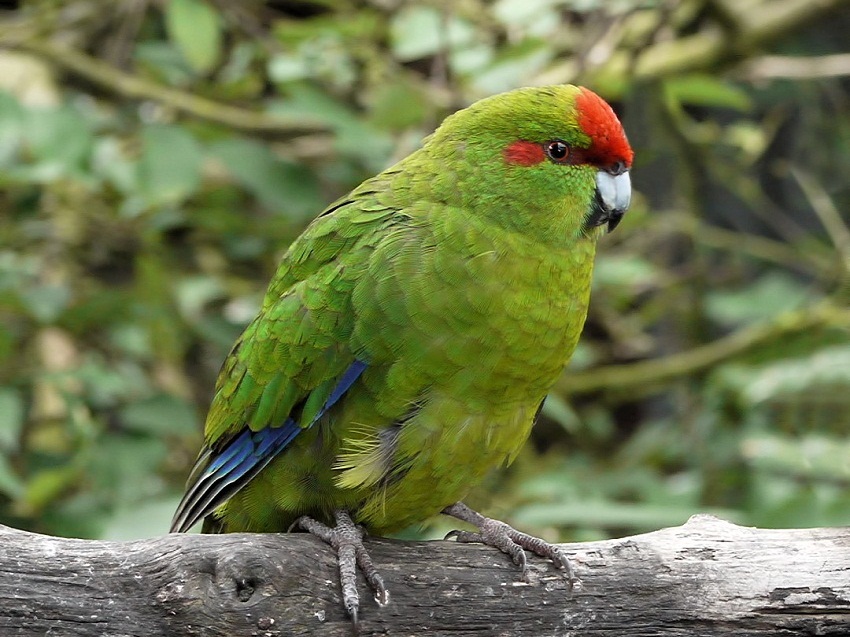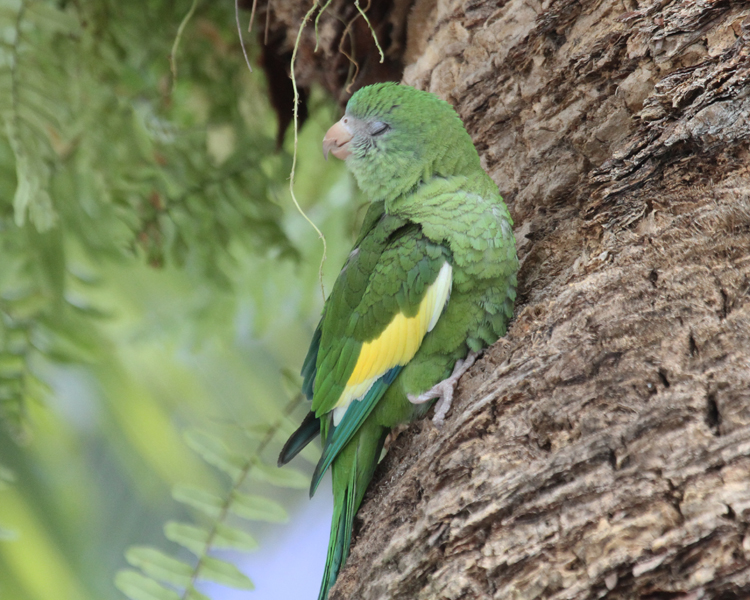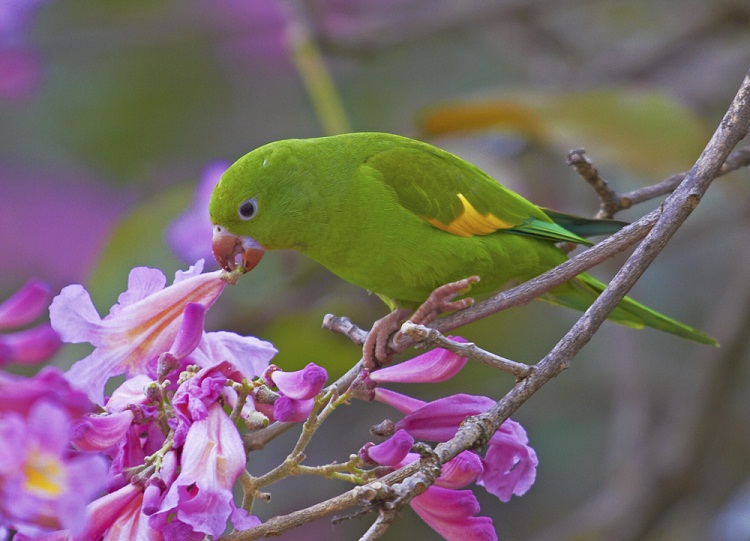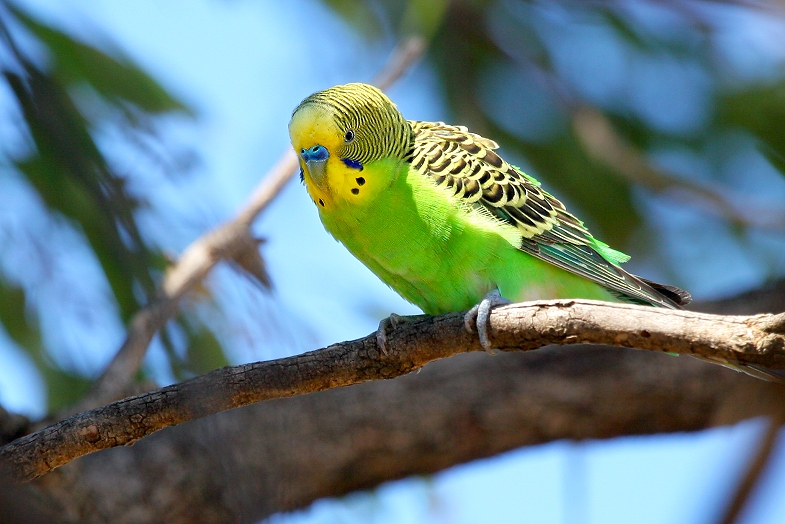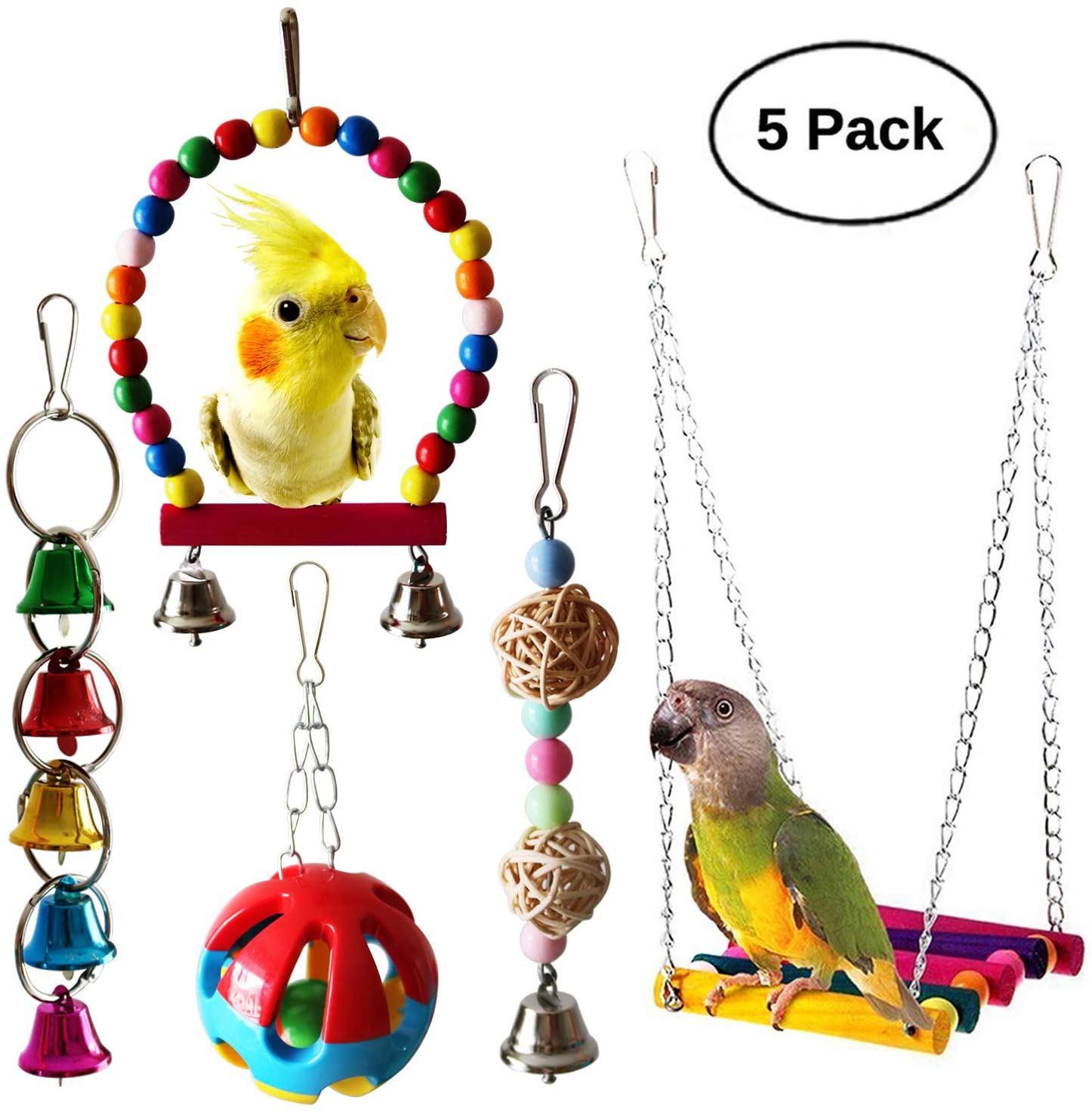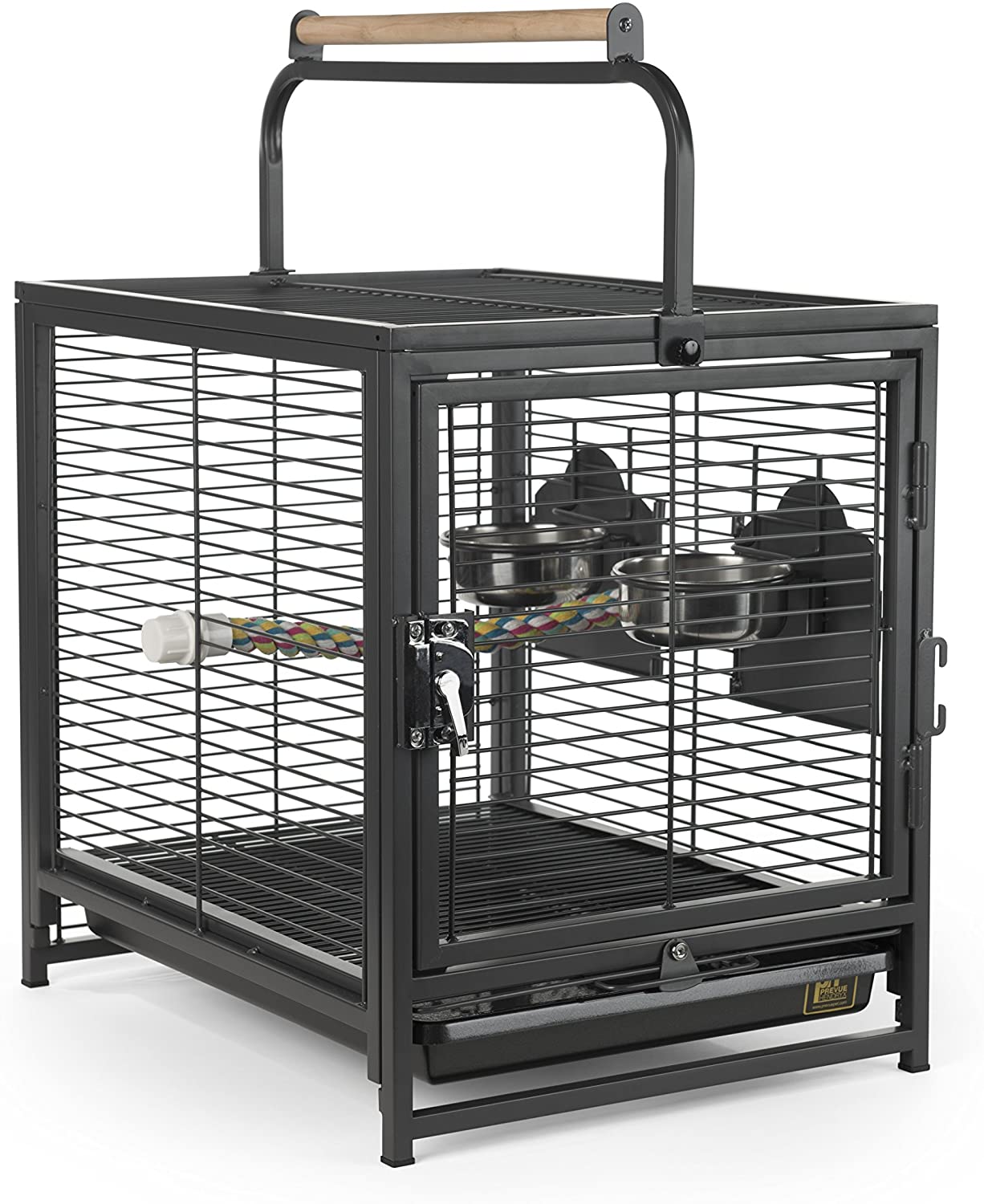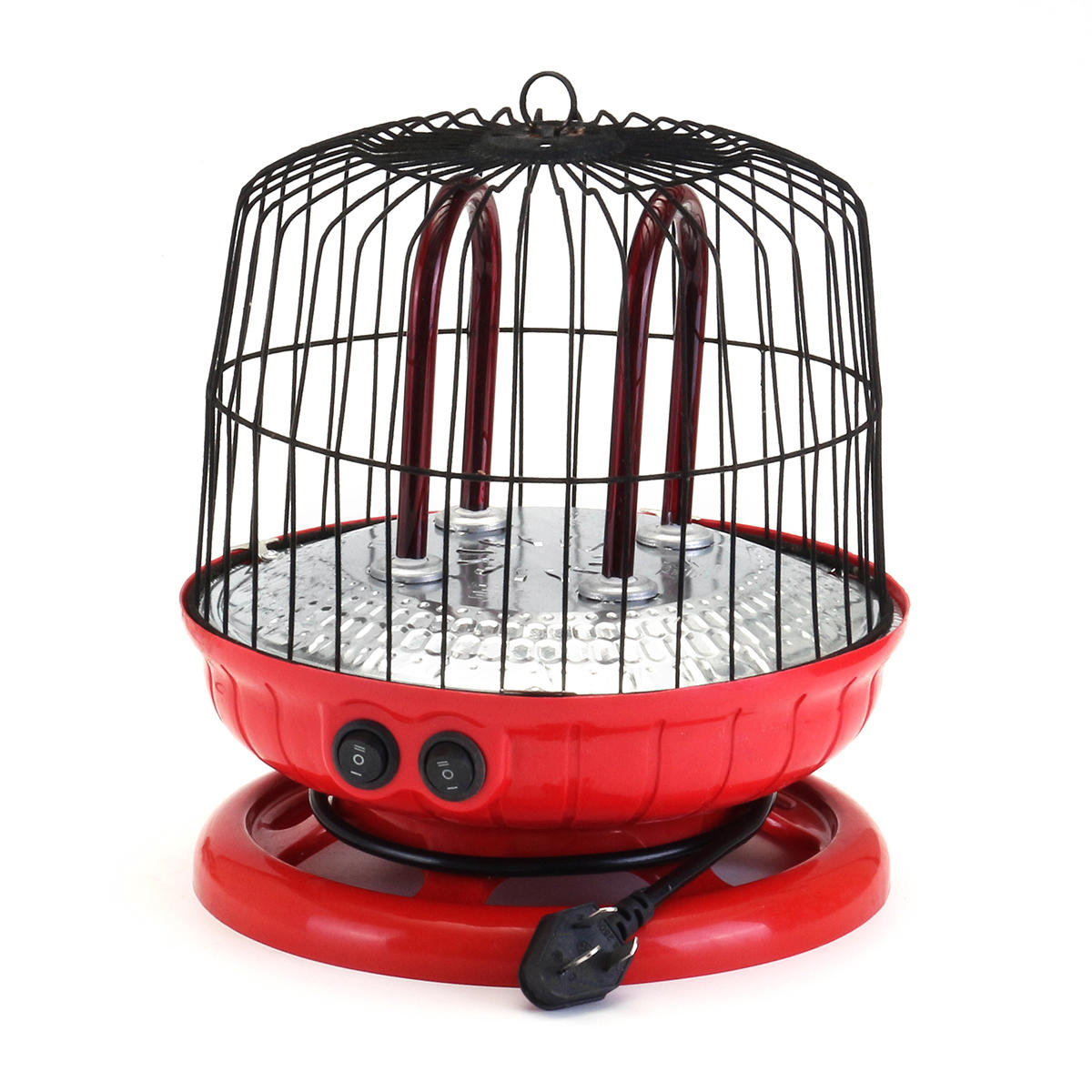Mustached parakeets, alternatively spelled moustached parakeets are parrots found in islands of Indonesia, South Asia, and Indochina. There are several subspecies of this bird, and they are also one of the most widespread species of their genus.
Scientific Classification |
|
| Kingdom | Animalia |
| Phylum | Chordata |
| Class | Aves |
| Order | Psittaciformes |
| Superfamily | Psittacoidea |
| Family | Psittaculidae |
| Subfamily | Psittaculinae |
| Tribe | Psittaculini |
| Genus | Psittacula |
| Scientific Name | Psittacula alexandri |
Quick Information |
|
| Also known as | Red-breasted parakeet |
| Description | Color: Males – Grey head with an attractive bluish tinge and a slender strip across the forehead and wider strips across the checks, green plumage, red beak, the color of the throat, breast and upper belly is a pink to salmon that runs half-way towards the vent; Females – They also have a bluish tinge around the face, and a duller pink color on the breast, black beak, and the tail feathers are shorter than those of males; Juveniles – They have light pink beaks, shorter strips on the face and also a shorter tail than adults, which makes them easily distinguishable from adults.
Size: 13-16 in (33-40 cm) in length |
| Subspecies |
|
| Distribution | Indonesian islands, Andaman Islands of India, also in the Indian mainland, Nepal, Bangladesh, Myanmar, Cambodia, Laos, and the Yunnan and Kwangsi Provinces in Southern China |
| Habitat | Mountains, hilly areas, and woodlands |
| Sounds & calls | Reasonably quite compared to other parrots. Excellent at learning to talk (males better than females). Makes sounds at dawn, noon and night |
| Breeding age | 2-3 years of age |
| Breeding season | December-April |
| Clutch size | 2-4 eggs |
| Incubation period | 22 days |
| Fledging | 52 days of age |
| Lifespan | 20-30 years |
| Diet | Fruits, seeds, and blossoms |
| IUCN Conservation Status | Near Threatened |
Mutations
- Turquoise
- Fallow
- Blue
As pets
These beautiful birds make great pets and as such are rather popular. Their talking ability, gentle disposition and overall friendly personality have gotten many pet-seekers lining up at pet stores and breeders to get one of these darlings.
Housing
A small macaw cage might be the best housing you can provide your mustached parakeet with, as they have a somewhat elongated tail. The minimum size of the cage should be 3’x2’x3’. Do not make two individuals share the cage; even keeping different genders can cause problems as the females tend to dominate males. Provide toys for the bird’s enrichment. It is advisable to keep breeding pairs in an outdoor aviary.
Temperature
They prefer a temperature of around 70°F.
Temperament
As previously mentioned, mustached parakeets have a jocund disposition, especially when hand-fed from a young age. They are rather curious, energetic, social and active birds who adore the time they get to spend with their owners. They tend to get needy when they feel they are not getting enough attention from their owners. Adolescent mustached parakeets are sometimes prone to get aggressive, often nipping, lunging and biting their owners, but this eventually goes away with age.
Feeding
They are not very fussy about what they are given to eat. Give them a varied diet consisting of a seed mixture and a high-quality pellet formula. You can also feed them any healthy food that you consume yourself.
Care
Replace the dirty food bowls and water dishes every day with clean ones. The floor of the enclosure should be cleaned every alternate week while the toys and perches must be cleaned every week. The entire enclosure needs to be disinfected at least once every year.
Health problems
The mustached parakeets are prone to suffer from the following ailments:
- Sarcocystosis
- Polyoma
- Aspergillosis
- Bacterial infections
- Psittacosis
- Hypovitaminosis A
Price
A mustached parakeet can cost between $500 and $600.
Interesting fact
- The scientific name of this bird is derived from Alexander the Great, who had introduced this bird in Greece.
Mustached parakeet Video
References:
Scientific Classification |
|
| Kingdom | Animalia |
| Phylum | Chordata |
| Class | Aves |
| Order | Psittaciformes |
| Superfamily | Psittacoidea |
| Family | Psittaculidae |
| Subfamily | Psittaculinae |
| Tribe | Psittaculini |
| Genus | Psittacula |
| Scientific Name | Psittacula alexandri |
Quick Information |
|
| Also known as | Red-breasted parakeet |
| Description | Color: Males – Grey head with an attractive bluish tinge and a slender strip across the forehead and wider strips across the checks, green plumage, red beak, the color of the throat, breast and upper belly is a pink to salmon that runs half-way towards the vent; Females – They also have a bluish tinge around the face, and a duller pink color on the breast, black beak, and the tail feathers are shorter than those of males; Juveniles – They have light pink beaks, shorter strips on the face and also a shorter tail than adults, which makes them easily distinguishable from adults.
Size: 13-16 in (33-40 cm) in length |
| Distribution & subspecies |
|
| Distribution | Indonesian islands, Andaman Islands of India, also in the Indian mainland, Nepal, Bangladesh, Myanmar, Cambodia, Laos, and the Yunnan and Kwangsi Provinces in Southern China |
| Habitat | Mountains, hilly areas, and woodlands |
| Sounds & calls |
|
| Breeding age | 2-3 years of age |
| Breeding season | December-April |
| Clutch size | 2-4 eggs |
| Incubation period | 22 days |
| Fledging | 52 days of age |
| Lifespan | 20-30 years |
| Diet | Fruits, seeds, and blossoms |
| IUCN Conservation Status | Near Threatened |
Mutations
- Turquoise
- Fallow
- Blue
As pets
These beautiful birds make great pets and as such are rather popular. Their talking ability, gentle disposition and overall friendly personality have gotten many pet-seekers lining up at pet stores and breeders to get one of these darlings.
Housing
A small macaw cage might be the best housing you can provide your mustached parakeet with, as they have a somewhat elongated tail. The minimum size of the cage should be 3’x2’x3’. Do not make two individuals share the cage; even keeping different genders can cause problems as the females tend to dominate males. Provide toys for the bird’s enrichment. It is advisable to keep breeding pairs in an outdoor aviary.
Temperature
They prefer a temperature of around 70°F.
Temperament
As previously mentioned, mustached parakeets have a jocund disposition, especially when hand-fed from a young age. They are rather curious, energetic, social and active birds who adore the time they get to spend with their owners. They tend to get needy when they feel they are not getting enough attention from their owners. Adolescent mustached parakeets are sometimes prone to get aggressive, often nipping, lunging and biting their owners, but this eventually goes away with age.
Feeding
They are not very fussy about what they are given to eat. Give them a varied diet consisting of a seed mixture and a high-quality pellet formula. You can also feed them any healthy food that you consume yourself.
Care
Replace the dirty food bowls and water dishes every day with clean ones. The floor of the enclosure should be cleaned every alternate week while the toys and perches must be cleaned every week. The entire enclosure needs to be disinfected at least once every year.
Health problems
The mustached parakeets are prone to suffer from the following ailments:
- Sarcocystosis
- Polyoma
- Aspergillosis
- Bacterial infections
- Psittacosis
- Hypovitaminosis A
Price
A mustached parakeet can cost between $500 and $600.
Interesting fact
- The scientific name of this bird is derived from Alexander the Great, who had introduced this bird in Greece.
Mustached parakeet Video
References:
Scientific Classification |
|
| Kingdom | Animalia |
| Phylum | Chordata |
| Class | Aves |
| Order | Psittaciformes |
| Superfamily | Psittacoidea |
| Family | Psittaculidae |
| Subfamily | Psittaculinae |
| Tribe | Psittaculini |
| Genus | Psittacula |
| Scientific Name | Psittacula alexandri |
Quick Information |
|
| Also known as | Red-breasted parakeet |
| Description | Color: Males – Grey head with an attractive bluish tinge and a slender strip across the forehead and wider strips across the checks, green plumage, red beak, the color of the throat, breast and upper belly is a pink to salmon that runs half-way towards the vent; Females – They also have a bluish tinge around the face, and a duller pink color on the breast, black beak, and the tail feathers are shorter than those of males; Juveniles – They have light pink beaks, shorter strips on the face and also a shorter tail than adults, which makes them easily distinguishable from adults.
Size: 13-16 in (33-40 cm) in length |
| Distribution & subspecies |
|
| Distribution | Indonesian islands, Andaman Islands of India, also in the Indian mainland, Nepal, Bangladesh, Myanmar, Cambodia, Laos, and the Yunnan and Kwangsi Provinces in Southern China |
| Habitat | Mountains, hilly areas, and woodlands |
| Sounds & calls |
|
| Breeding age | 2-3 years of age |
| Breeding season | December-April |
| Clutch size | 2-4 eggs |
| Incubation period | 22 days |
| Fledging | 52 days of age |
| Lifespan | 20-30 years |
| Diet | Fruits, seeds, and blossoms |
| IUCN Conservation Status | Near Threatened |
Mutations
- Turquoise
- Fallow
- Blue
As pets
These beautiful birds make great pets and as such are rather popular. Their talking ability, gentle disposition and overall friendly personality have gotten many pet-seekers lining up at pet stores and breeders to get one of these darlings.
Housing
A small macaw cage might be the best housing you can provide your mustached parakeet with, as they have a somewhat elongated tail. The minimum size of the cage should be 3’x2’x3’. Do not make two individuals share the cage; even keeping different genders can cause problems as the females tend to dominate males. Provide toys for the bird’s enrichment. It is advisable to keep breeding pairs in an outdoor aviary.
Temperature
They prefer a temperature of around 70°F.
Temperament
As previously mentioned, mustached parakeets have a jocund disposition, especially when hand-fed from a young age. They are rather curious, energetic, social and active birds who adore the time they get to spend with their owners. They tend to get needy when they feel they are not getting enough attention from their owners. Adolescent mustached parakeets are sometimes prone to get aggressive, often nipping, lunging and biting their owners, but this eventually goes away with age.
Feeding
They are not very fussy about what they are given to eat. Give them a varied diet consisting of a seed mixture and a high-quality pellet formula. You can also feed them any healthy food that you consume yourself.
Care
Replace the dirty food bowls and water dishes every day with clean ones. The floor of the enclosure should be cleaned every alternate week while the toys and perches must be cleaned every week. The entire enclosure needs to be disinfected at least once every year.
Health problems
The mustached parakeets are prone to suffer from the following ailments:
- Sarcocystosis
- Polyoma
- Aspergillosis
- Bacterial infections
- Psittacosis
- Hypovitaminosis A
Price
A mustached parakeet can cost between $500 and $600.
Interesting fact
- The scientific name of this bird is derived from Alexander the Great, who had introduced this bird in Greece.
Mustached parakeet Video
References:
Scientific Classification |
|
| Kingdom | Animalia |
| Phylum | Chordata |
| Class | Aves |
| Order | Psittaciformes |
| Superfamily | Psittacoidea |
| Family | Psittaculidae |
| Subfamily | Psittaculinae |
| Tribe | Psittaculini |
| Genus | Psittacula |
| Scientific Name | Psittacula alexandri |
Quick Information |
|
| Also known as | Red-breasted parakeet |
| Description | Color: Males – Grey head with an attractive bluish tinge and a slender strip across the forehead and wider strips across the checks, green plumage, red beak, the color of the throat, breast and upper belly is a pink to salmon that runs half-way towards the vent; Females – They also have a bluish tinge around the face, and a duller pink color on the breast, black beak, and the tail feathers are shorter than those of males; Juveniles – They have light pink beaks, shorter strips on the face and also a shorter tail than adults, which makes them easily distinguishable from adults.
Size: 13-16 in (33-40 cm) in length |
| Distribution & subspecies |
|
| Distribution | Indonesian islands, Andaman Islands of India, also in the Indian mainland, Nepal, Bangladesh, Myanmar, Cambodia, Laos, and the Yunnan and Kwangsi Provinces in Southern China |
| Habitat | Mountains, hilly areas, and woodlands |
| Sounds & calls |
|
| Breeding age | 2-3 years of age |
| Breeding season | December-April |
| Clutch size | 2-4 eggs |
| Incubation period | 22 days |
| Fledging | 52 days of age |
| Lifespan | 20-30 years |
| Diet | Fruits, seeds, and blossoms |
| IUCN Conservation Status | Near Threatened |
Mutations
- Turquoise
- Fallow
- Blue
As pets
These beautiful birds make great pets and as such are rather popular. Their talking ability, gentle disposition and overall friendly personality have gotten many pet-seekers lining up at pet stores and breeders to get one of these darlings.
Housing
A small macaw cage might be the best housing you can provide your mustached parakeet with, as they have a somewhat elongated tail. The minimum size of the cage should be 3’x2’x3’. Do not make two individuals share the cage; even keeping different genders can cause problems as the females tend to dominate males. Provide toys for the bird’s enrichment. It is advisable to keep breeding pairs in an outdoor aviary.
Temperature
They prefer a temperature of around 70°F.
Temperament
As previously mentioned, mustached parakeets have a jocund disposition, especially when hand-fed from a young age. They are rather curious, energetic, social and active birds who adore the time they get to spend with their owners. They tend to get needy when they feel they are not getting enough attention from their owners. Adolescent mustached parakeets are sometimes prone to get aggressive, often nipping, lunging and biting their owners, but this eventually goes away with age.
Feeding
They are not very fussy about what they are given to eat. Give them a varied diet consisting of a seed mixture and a high-quality pellet formula. You can also feed them any healthy food that you consume yourself.
Care
Replace the dirty food bowls and water dishes every day with clean ones. The floor of the enclosure should be cleaned every alternate week while the toys and perches must be cleaned every week. The entire enclosure needs to be disinfected at least once every year.
Health problems
The mustached parakeets are prone to suffer from the following ailments:
- Sarcocystosis
- Polyoma
- Aspergillosis
- Bacterial infections
- Psittacosis
- Hypovitaminosis A
Price
A mustached parakeet can cost between $500 and $600.
Interesting fact
- The scientific name of this bird is derived from Alexander the Great, who had introduced this bird in Greece.
Mustached parakeet Video
References:


